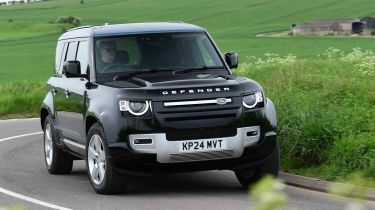Land Rover Defender - Engines, performance and drive
The Land Rover Defender has a strong range of engines and a comfortable ride, but it’s still good off-road

Land Rover’s engineers were tasked with ensuring the Defender could cope with everything expected off-road, before focusing on its on-road dynamics. Bearing that in mind, they’ve nailed the brief, because it feels like it’ll keep even the keenest 4x4 driver happy.
The Defender features either a coil or air suspension system depending on the spec, but all come with a low-ratio gearbox for greater control of the engine’s power over tricky obstacles, a locking centre differential to make sure that it is split evenly between the front and rear wheels to improve traction, and the manufacturer’s latest Terrain Response tech. The latter includes various driving modes that automatically adjust various driving parameters to make it a doddle to drive across whatever terrain you point it at.
All this off-road ability doesn’t come at the expense of on-road civility, however. The 22-inch wheels on X trim and V8 models firm up the ride a bit, but when fitted with smaller wheels, the Defender will appeal as much to the family SUV buyer as it does to the traditional agricultural sorts who loved the old one.
| Model | Power | 0-62mph | Top speed |
| Land Rover Defender 110 D250 | 247bhp | 7.9 seconds | 117mph |
| Land Rover Defender OCTA | 626bhp | 3.8 seconds | 155mph |
| Land Rover Defender 110 D350 | 296bhp | 6.1 seconds | 119mph |
What is the Land Rover Defender like to drive?
In town
Something you’ll notice immediately in the Defender is that it’s not the liveliest around town. There’s a big steering wheel that requires frequent input, and the transmission can be laboured. There’s a bit of lean during tight cornering and even the three-door 90 feels big in urban areas. Visibility up front is pretty good, despite a relatively long and high bonnet – it’s quite easy to place the slab-sided Defender on the road.
On A- and B-roads
The slow steering is a trait shared with the Ineos Grenadier, so the steering wheel isn’t wrenched from your hands while going over obstacles off-road. As you’d expect, the Defender isn’t a car you relish throwing around a B-road, although it’s a little more composed than its off-road focus might suggest. There’s a decent amount of grip and in the right gear, the straight-six diesel is a joy. V8 models obviously have straight-line performance (and an accompanying soundtrack) to excite, but they still feel utilitarian. For instance, pulling away from a junction, you’ll notice a lot of pitch – so much so that at night, the Defender’s headlight beam will blind oncomers.
On the motorway
The Defender has soft, long-travel suspension, which ensures all wheels maintain grip with the ground even when the suspension is articulated over an obstacle. This means that when pushed through corners at speed, the Defender will lean more than a BMW X5 would. The way it does this is predictable, though, and you quickly get used to it, adopting a more relaxed driving style. We’ve found that its softer suspension also pays off in terms of ride comfort, because the Defender (on smaller wheels) is remarkably supple even over rough sections of Tarmac.
0-62mph acceleration and top speed
A base-level Defender 90 D250 will sprint from 0-60mph in a reasonably brisk 7.6 seconds, before topping out at 117mph. It’s a 248bhp 3.0-litre straight-six, yes, but it’s not the smoothest of engines; the power can feel a little lumpy through the rev range, but overall it’s pretty unstressed in the Defender – especially in the smaller 90.
Used - available now

2020 Land Rover
Defender
40,000 milesAutomaticDiesel2.0L
Cash £49,990
2025 Land Rover
Defender
21,000 milesAutomaticDiesel3.0L
Cash £69,990
2025 Land Rover
Defender
3,895 milesAutomaticDiesel3.0L
Cash £67,995
2020 Land Rover
Defender
32,815 milesAutomaticDiesel2.0L
Cash £50,174With 345bhp and 700Nm of torque (resulting in a rapid 5.6-second 0-60mph sprint) the D350 has plenty of punch and actually offers identical efficiency to the D250, with both featuring mild-hybrid technology.
If the torquey, but slightly unrefined, diesels aren’t to your liking, there’s a plug-in hybrid Defender P300e to consider. Available only on the 110, it has a four-cylinder, 2.0-litre turbocharged petrol engine with 296bhp and a 0-60mph time of 7.4 seconds. The transition from electric to petrol, or vice versa, is pretty seamless.
A P425 petrol option joined the range in 2024, replacing the old P400. It features a supercharged 5.0-litre V8 with 419bhp and 550Nm of torque, enough to propel it to 60mph in 5.5 seconds.
The first real ‘performance’ option is the supercharged Defender V8, which pumps out 518bhp and 625Nm of torque in the 90, while the bigger 130 has to make do with a slightly less potent version of the same engine with 493bhp and 610Nm of torque; this V8 is no longer offered on the 110. The 90 V8 promises a 0-62mph time of 4.9 seconds, while the 130 V8 takes a little longer, at 5.4 seconds.
Joining the line-up in 2024 was the Defender OCTA, which makes use of a 4.4-litre twin-turbocharged V8 from BMW’s M division. While it provides a different soundtrack to the wailing supercharged V8s, there should be no qualms with the power on offer. With 626bhp and up to 750Nm of torque, the OCTA is simply the most powerful Defender ever. The 110 OCTA manages the 0-60mph sprint in a supercar-troubling 3.8 seconds.








